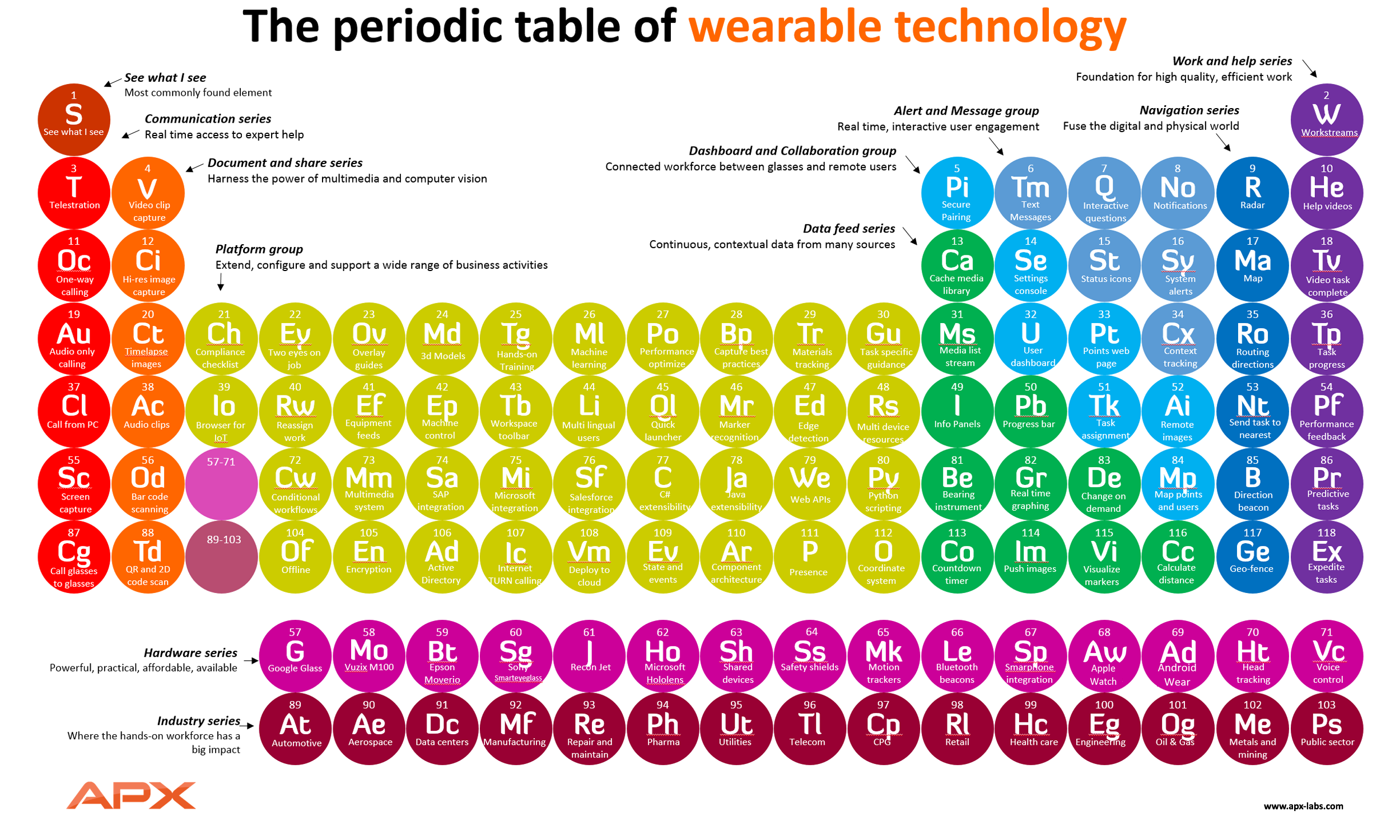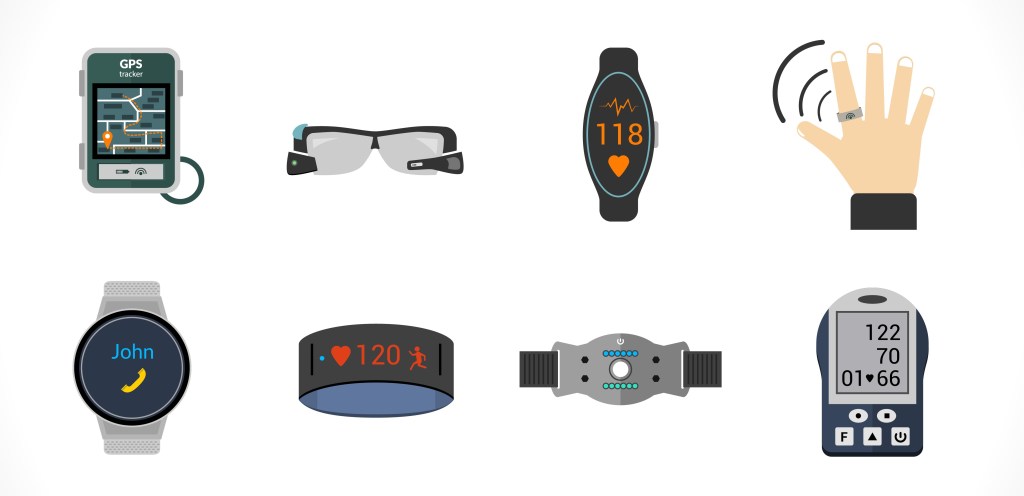Brian Ballard
More posts from Brian Ballard
There is a surprisingly rich ecosystem of devices, a plethora of uses, and importantly, a wealth (both in quantity and value) of markets that are investigating the value of wearables in the enterprise.
To capture the different hardware types, uses, and common capabilities we’ve seen applied to wearables, our Periodic Table of Wearable Technology groups together the major elements of wearables to outline what executives need to know before deploying these devices to their workforce.
This is probably an appropriate time to note that there are no “radioactive elements” when it comes to wearables. Explosive situations only occur when wearable technology is abused or common sense is checked at the door.

We used the periodic table to extract a framework and put some organization around the huge surface of wearable technology. Each item in a color-coded group is related to each other in some important way, just like the real periodic table. Instead of atomic number and chemical properties, we use value-prop and underlying technologies.
We look at the elements first by Industry Series (bottom row) consisting of automotive manufacturers, telecoms, utilities and others. These elements are the foundation of the market, the users of wearable technology and the primary drivers for the rest of the chart. Wearables will have a profound impact on businesses of all types, in just about every industry.
They enable scenarios that are impossible to do in any other way, and in particular hands-on operational work. This is the killer app for wearables and so the Industry Series is built around companies with lots of people who build, fix, move and operate things.
Every other element on the table represents some capability or need that these different types of companies have expressed to us. While the specific use cases differ slightly between industries, the core capabilities and end-user are highly common across them. Combining these common individual elements is how businesses are solving real problems today.
The Hardware Series (second row from the bottom) is the collection of devices – smart glasses, smartwatches, and some of the peripherals – that, when combined with the other Industry Series elements, help businesses get things done. Not every device is created equal or is even able to perform every possible use case. But with experience, an enterprise can quickly find the right tool for the right job.
You’ll see that standing in for Hydrogen, the most common element, is See What I See. It really does represent the most requested feature. The reason is that there is a universal need and huge value in delivering immediate access to expert help. Getting two sets of eyes on the job can make solving a problem faster, improve the quality and even allow lower-skilled resources to do high-skilled work with a little over-the-shoulder coaching.
We also operate solutions for many global companies and having a point of view video feed immediately versus having to fly an expert around the world is a big driver for ROI.
Decoding the rest of the elements, the important thing to understand is how we’ve organized them into groups. The Communication Series represents different high-level concept requirements to enable real-time collaboration. This includes the ability to access expert help in real-time through video collaboration, telestration, audio calling, screen capture and more.
A business’s need to capture, transmit, and interact with key media is expressed in the Document and Share Series. These features include video and audio capture, high-resolution image capture, time-lapse images and barcode and QR code scanning.
Work and Help Series elements are the things that end-users need to get their job done effectively. These include individual work requirements such as workstreams, the ability to capture and view help videos, expedite tasks and more. These are what business leaders see as value drivers for their operations.
The ROI delivered from this family of elements is demonstrated in improved training, access to stored guidance from experts and the ability to easily pass “tribal knowledge” and skills from more experienced employees to new hires.
Wearables are the essential last-mile to creating a fully connected enterprise.
Wearables in a business setting must interact with an existing ecosystem of applications and technologies that already exist. How are wearable devices accessing these knowledge systems? That’s the Platform group. These (and if you’ve ever delivered a product to a F500 company’s IT department or met their OSHA requirements you know what I’m talking about) are the many minimum requirements that have to be supported in order to even qualify as a deployable tool for those users.
If you are building a wearable product for the market and you have no way to store security certificates, access enterprise Wi-Fi, or touch Active Directory, then you probably aren’t going far in enterprise.
If you’re a buyer, save yourself a lot of pain in the integration process and ask about those things up front. Does your business’s production line run off of SAP, collaborate using Microsoft, and harness IOT machine data? You’ll need an interface to your wearable devices that can integrate with your existing production investments. The good news is, there is a lot of work being done at every level of the industry to meet these requirements.
We think that wearables are the essential last-mile to creating a fully connected enterprise. When that happens you will see great evolutionary leaps in the flexibility and performance of your most important business processes.
The often-expressed requirement to extend the Industrial Internet to the workforce and the ability to interact with a continuously evolving landscape of data and sensor output is expressed in the Data feed Series. These elements include the ability to provide real-time graphing and progress bars, visualize markers and calculate distances, work with bearing instruments and more.
Interfacing with teams, system alerts, IoT-based triggers, and the backend reporting on these interactions is represented through the Dashboard and Collaboration and the Alert and Message groups. These are surprisingly simple features that unlock wonderful capabilities for businesses that want to embrace or encourage a truly connected workforce where the members of their team can quickly interact with the people and systems around them without having to go find a terminal. Many of these features are perfect for the newly popular smartwatch hardware category.
Last but not least, we have grouped many of the component requirements that let businesses take advantage of the bridge between the physical and digital worlds in the Navigation Series. Devices like the Microsoft HoloLens are pushing the envelope of how users understand where they are in local space but just about every wearable in the Hardware Series benefits from things like coarse geofencing and Bluetooth beacon-based proximity sensing in industrial environments.
One of the true differentiators between wearables and other traditional devices is their ability to operate in the real world, understanding location, capturing rich context and making decisions around all that. We’re finding new and novel uses for these wearable tech elements every day. It’s exciting to see how smart glasses, smartwatches and other peripherals are being used to change the practical, day-to-day activities of people in different industries.































Comment